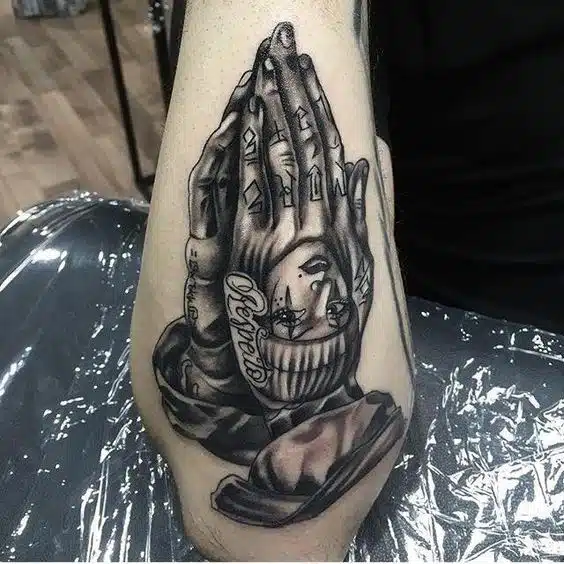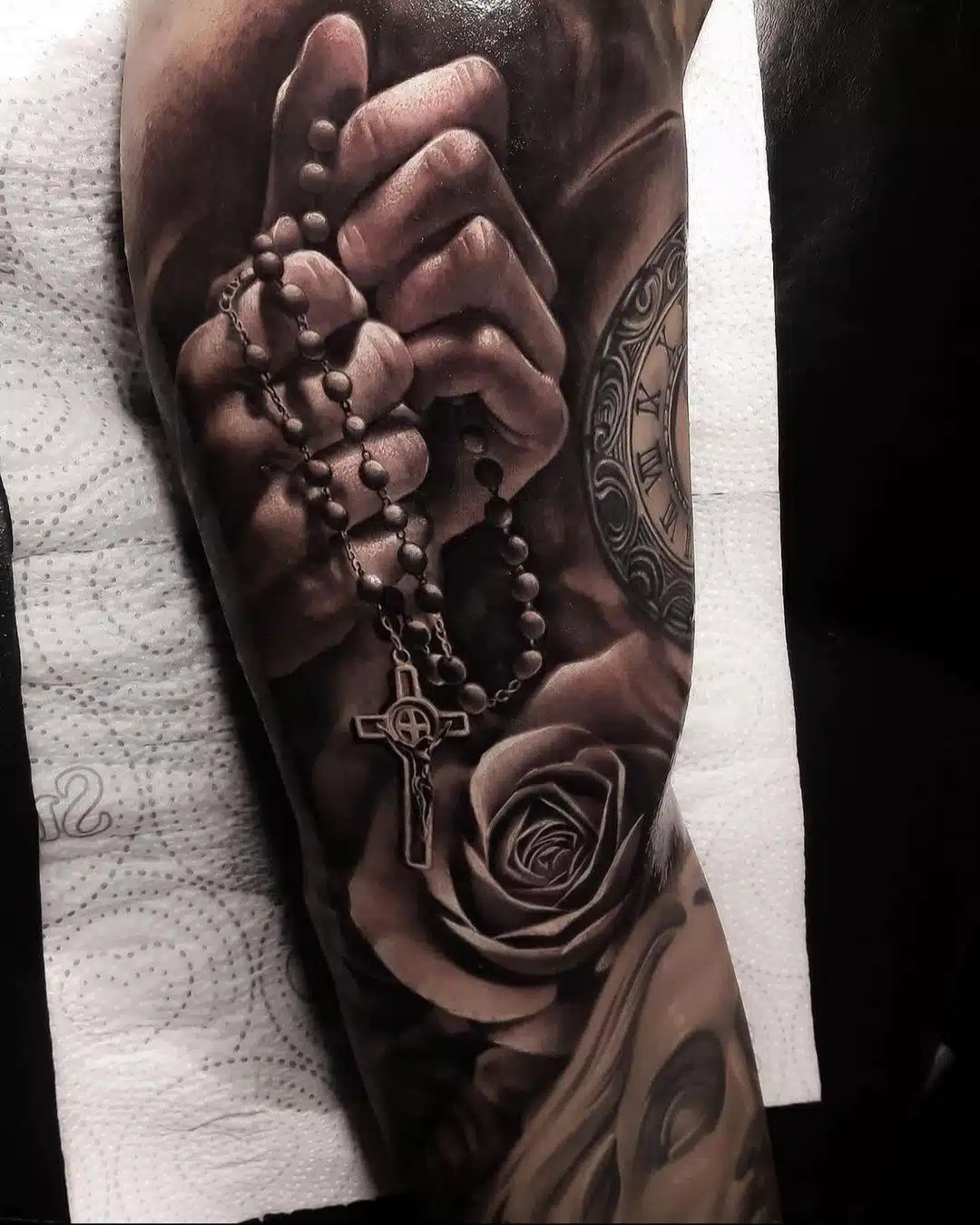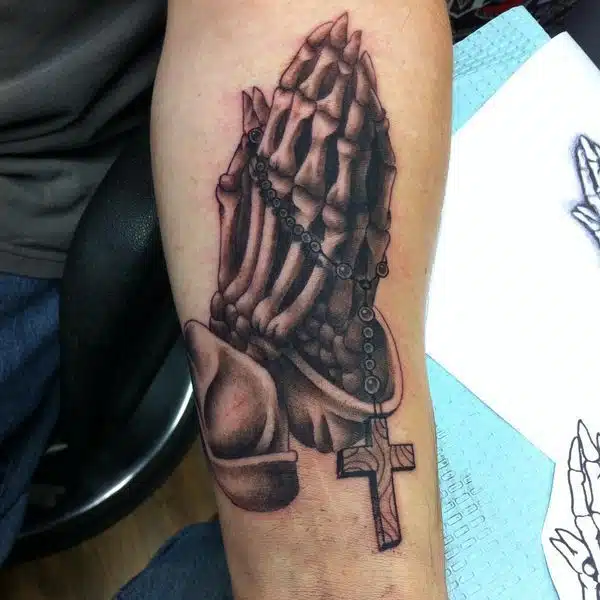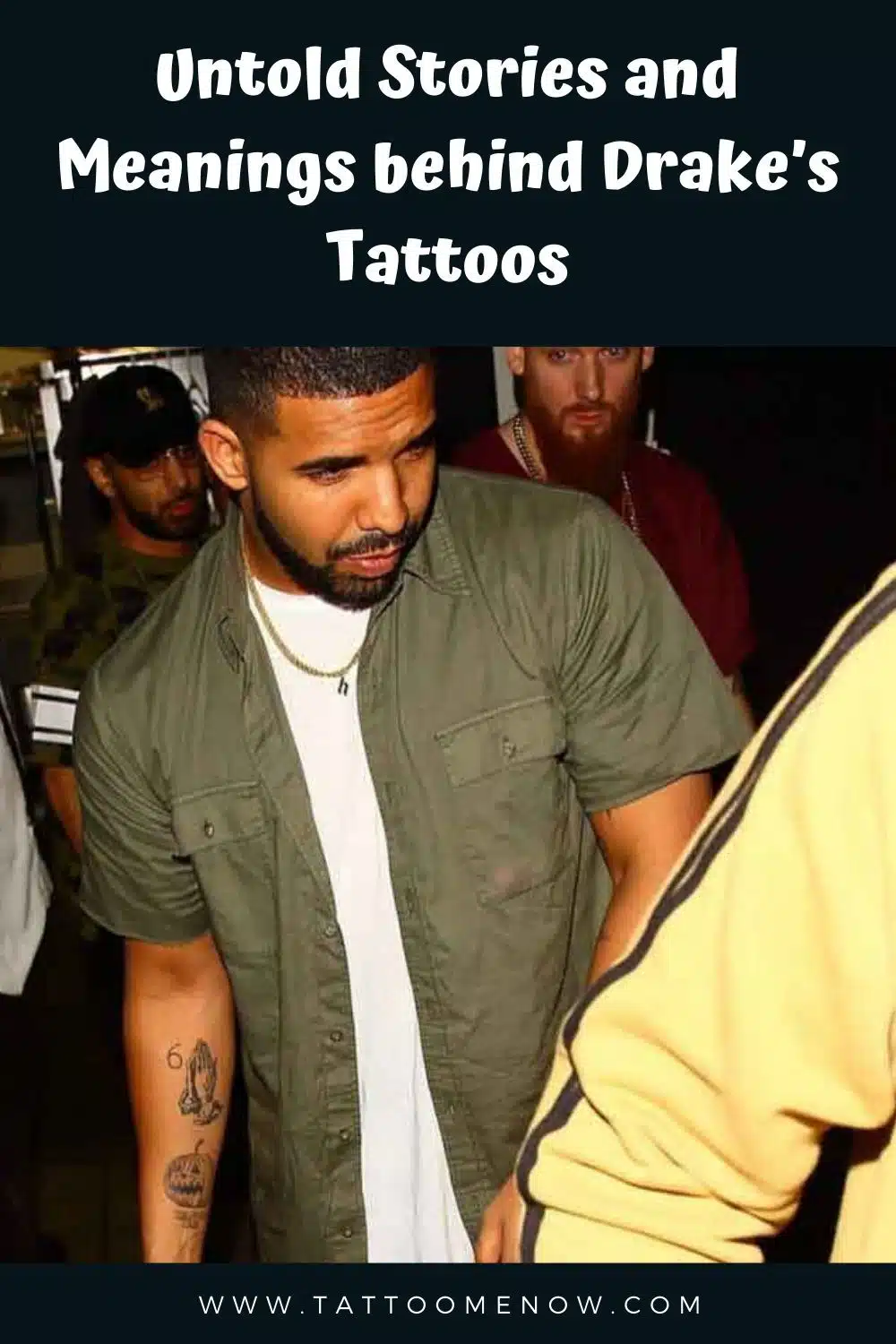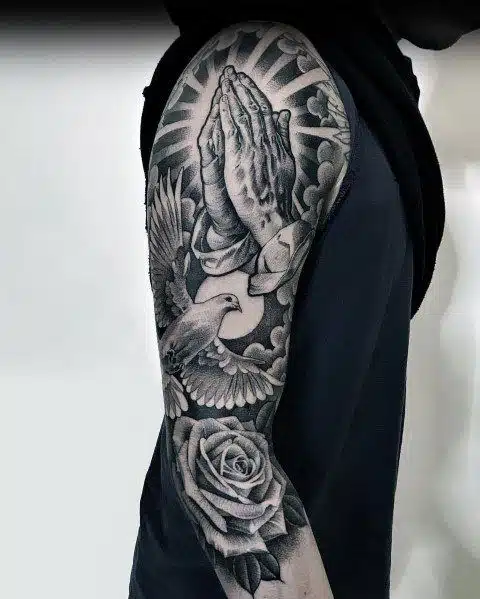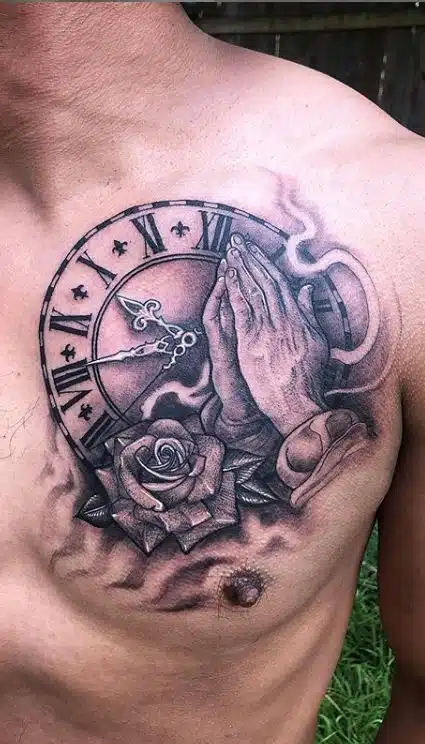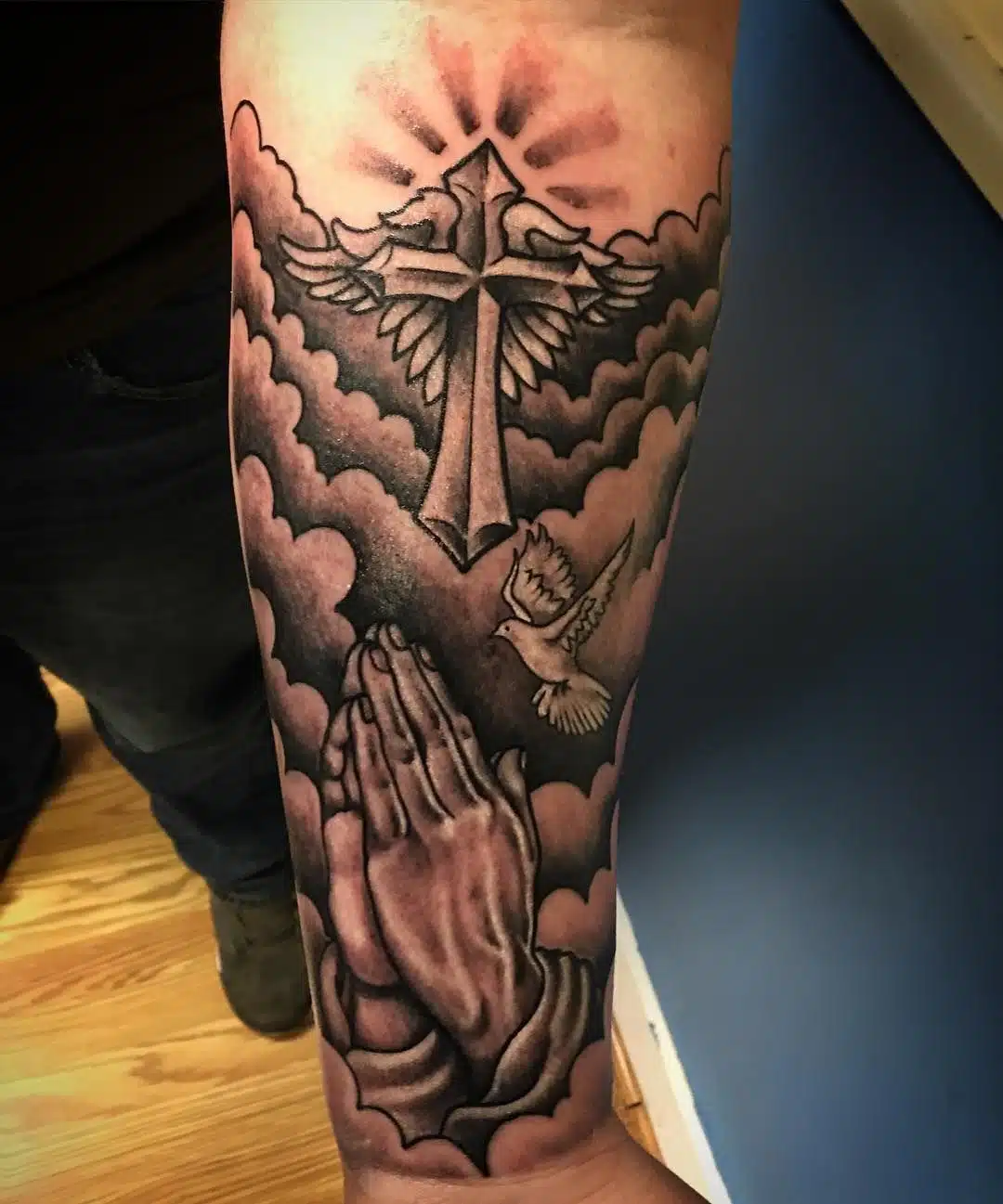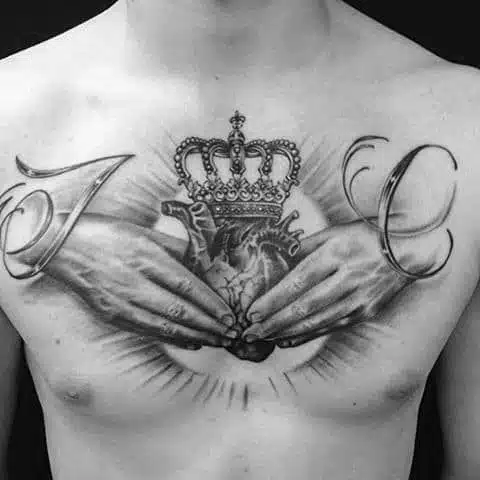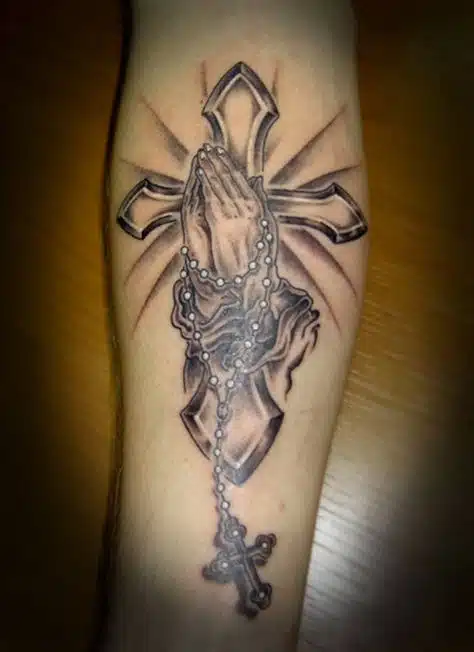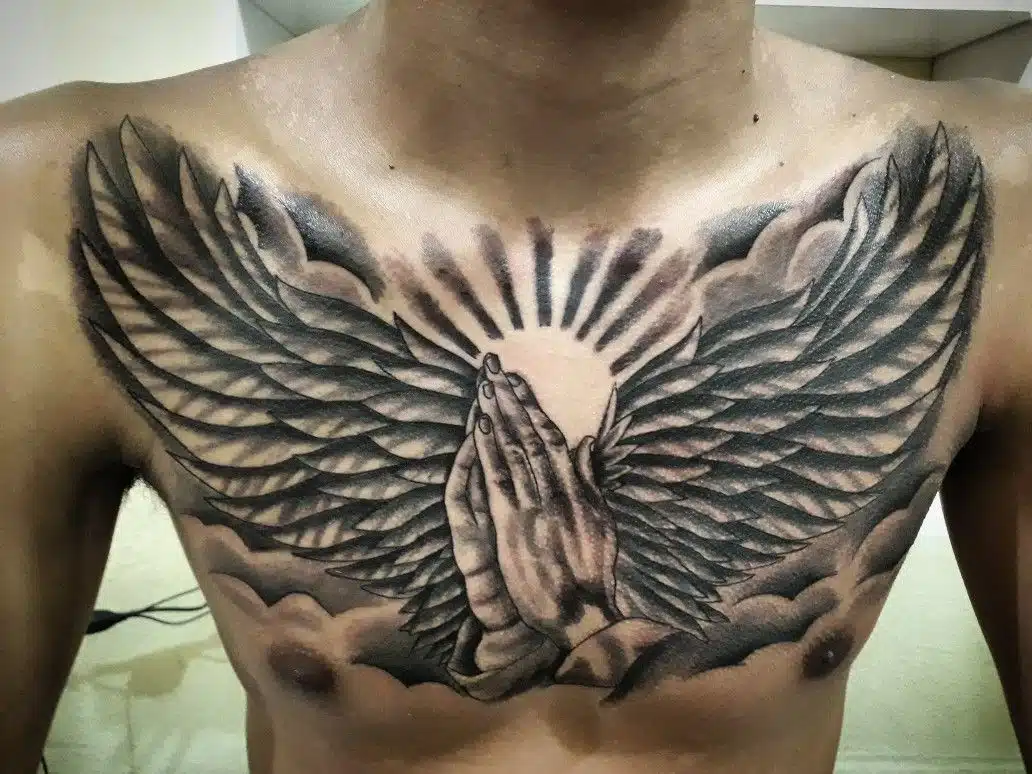Praying hands tattoos are a popular choice for both men and women. They are usually placed on the wrists, shoulders, or back. The praying hand's tattoo is a religious tattoo with deep meaning. It can represent faith, hope, love, or prayer.
Are you only interested in tattoo designs and want to skip the educational part?
No problem, we got you covered! Click HERE to get inspired.
What do praying hands mean?
Praying hands are a gesture often associated with religious or spiritual practices, and are commonly used to represent prayer, faith, or devotion. The gesture is typically made by pressing the palms of the hands together, with the fingers extended upward and the thumbs touching the chest or forehead.
The praying hands gesture is most commonly associated with Christianity, but it is also used in other religions and spiritual practices, such as Hinduism, Buddhism, and Islam. In Christianity, the gesture is often seen as a symbol of humility, gratitude, and reverence, and is used in prayer and worship.
The origins of the praying hands gesture are not clear, but it is thought to have originated in the early Christian church as a way for worshippers to show reverence and humility during prayer. Over time, the gesture became more formalized and was adopted as a symbol of faith and devotion.
Today, the praying hands gesture is widely recognized as a symbol of prayer, and is often used in religious art, iconography, and symbolism. It is also used in everyday life as a way to express gratitude, humility, or reverence, and is sometimes used as a greeting or farewell gesture.
What does a praying hand tattoo symbolize?
A praying hands tattoo can symbolize a variety of meanings, depending on the person wearing it and their personal beliefs and experiences. However, some common interpretations of a praying hands tattoo include:
Faith and devotion: The praying hands tattoo can represent a person's faith in a higher power or their commitment to a particular religion or spiritual practice.
Prayer and hope: The tattoo can serve as a reminder of the power of prayer and the hope that it can bring to one's life.
Gratitude and humility: The gesture of praying hands is often associated with humility and gratitude, and a tattoo of this symbol can serve as a reminder to be thankful and humble in one's life.
Remembrance: A praying hands tattoo can also be a way to honor and remember a loved one who has passed away, or to commemorate a significant event or experience in one's life.
Strength and resilience: For some people, the praying hands tattoo can represent strength and resilience in the face of adversity or challenging times.
Ultimately, the meaning of a praying hands tattoo will depend on the individual wearing it and the personal significance that it holds for them.
best Praying Hands Tattoo ideas and their meanings
There are many different designs of a prayer hands tattoo. Some people choose to get a simple tattoo of two hands praying. Others may add elements such as crosses, rosary beads, or angels. No matter what design you choose, the meaning behind the tattoo will be the same. Below are some examples of different praying hands tattoo designs:
Gang praying hands tattoo
Although their graffiti is often more understandable than other gangs, their tattoos are highly symbolic and usually only meant to be understood by initiated members. A praying hands tattoo is common among gangsters and signifies asking God for forgiveness. The Our Lady of Guadalupe icon is another favorite tattoo worn by gang members as it holds great religious significance.
Praying hands with rosary tattoo
Hands and rosary beads are common tattoo designs that symbolize prayer, meditation, and deep spirituality. The tattoo often features folded hands or praying hands holding the rosary with the beads wrapped around the hands or falling between the fingers.
Skeleton praying hands tattoo
Some say skeleton hand tattoos signify respect for lost loved ones. However, many believe that the trend is simply another passing fad.
Drake's praying hands tattoo
Drake, who famously refers to himself as the "6 God," has a tattoo of praying hands and the number 6 on his forearm. This is about his Toronto roots (area code 416).
Praying hands and dove tattoo
The praying hands and dove tattoo is a design that symbolizes peace, hope, and love. The dove is a universal symbol of peace, and the praying hands symbolize faith. This tattoo is often worn by people who have gone through tough times and are looking for a new beginning.
Praying hands with clock tattoo
The prayer hands tattoo with a clock is a design that symbolizes time running out or the clock ticking. This tattoo is often worn by people who are facing a life-threatening illness or are in prison. It can also be a reminder to live each day to the fullest.
Praying hands with clouds tattoo
The praying hands with clouds tattoo is a design that symbolizes hope. The clouds represent the sky and the infinite possibilities that lie ahead. This tattoo is often worn by people who are going through tough times and looking for hope.
Praying hands with heart tattoo
The praying hands with heart tattoo is a design that symbolizes love. The heart is a universal symbol of love, and the praying hands symbolize faith. This tattoo is often worn by people who are in love or have gone through tough times and are looking for love.
Praying hands with a cross tattoo
The praying hands with a cross tattoo is a design that symbolizes faith. The cross is a universal symbol of faith, and the praying hands symbolize prayer. This tattoo is often worn by religious people who have gone through tough times in their life and are looking for guidance.
Praying hands with angel wings tattoo
The praying hands with angel wings tattoo is a design that symbolizes protection. The angel wings represent the protection of angels, and the praying hands symbolize faith. This tattoo is often worn by people who are going through tough times and looking for protection.
So as you can see, the praying hands tattoo can symbolize various things depending on the design. Whether you choose a simple design or something more elaborate, the meaning is up to you. So if you're looking for a tattoo with deep meaning, the praying hands tattoo may be a perfect choice.
General Breakdown Of Tattoo Pain Levels On Different Body Parts
Here is a breakdown of the different tattoo pain levels:
- Low: This level of pain is generally described as a mild discomfort or tickling sensation. It is similar to the sensation of getting a light scratch or scrape.
- Moderate: This level of pain is generally described as a moderate discomfort or aching sensation. It is similar to the sensation of getting a deep scratch or scrape or being pinched.
- High: This level of pain is generally described as a strong discomfort or throbbing sensation. It is similar to the sensation of getting a burn or being stung by a bee.
It's important to note that pain tolerance is highly individual and can vary greatly from person to person. Some people may find certain body parts more or less painful than others, and the same body part can be more or less painful for different people. Additionally, the level of pain can be affected by factors such as the size and location of the tattoo, the skill of the tattoo artist, and the individual's own pain threshold.
Tattoo placement pain level chart
Body Part | Pain Level | Explanation |
Forehead | Low | The forehead has few nerve endings, so it is not a particularly painful area. |
Eyebrows | Low | The eyebrows have few nerve endings, so the pain level is relatively low. |
Ear | Low | The ear is a relatively thin and fleshy area, so the pain level is low. |
Nostril | Low | The nostril is a small area with thin skin, so the pain level is low. |
Lip | Low to Moderate | The lip has more nerve endings than some other areas, so it may be slightly more painful. |
Cheek | Low to Moderate | The cheek has a moderate amount of nerve endings, so it may be slightly more painful. |
Moderate | The neck has a moderate amount of nerve endings, so it may be slightly more painful. | |
Moderate to High | The chest has a high concentration of nerve endings, so it can be quite painful. | |
Abdomen | High | The abdomen has a high concentration of nerve endings, so it can be quite painful. |
Back | High | The back has a high concentration of nerve endings, so it can be quite painful. |
Shoulders | High | The shoulders have a high concentration of nerve endings, so they can be quite painful. |
Upper Arms | Moderate to High | The upper arms have a moderate to high concentration of nerve endings, so they can be somewhat painful. |
Elbows | High | The elbows have a high concentration of nerve endings, so they can be quite painful. |
Forearms | Moderate | The forearms have a moderate concentration of nerve endings, so they are not as painful as some other areas. |
Hands | High | The hands have a high concentration of nerve endings, so they can be quite painful. |
Lower Arms | Low to Moderate | The lower arms have a lower concentration of nerve endings, so they are not as painful as some other areas. |
Wrists | Low | The wrists have a low concentration of nerve endings, so they are not very painful. |
Lower Back | High | The lower back has a high concentration of nerve endings, so it can be quite painful. |
Buttocks | High | The buttocks have a high concentration of nerve endings, so they can be quite painful. |
Thighs | High | The thighs have a high concentration of nerve endings, so they can be quite painful. |
Knees | High | The knees have a high concentration of nerve endings, so they can be quite painful. |
Calves | Low to Moderate | The calves have a low to moderate concentration of nerve endings, so they are not as painful as some other areas. |
Ankles | Low | The ankles have a low concentration of nerve endings, so they are not very painful. |
Tattoo aftercare tips
Before getting a tattoo:
Choose a reputable tattoo artist and parlor. Research the artist's portfolio and read reviews from previous clients.
Consult with the artist about the design and placement of the tattoo.
Make sure you are in good health. If you have any medical conditions or are taking any medications that may affect your ability to heal, be sure to let your tattoo artist know.
Consider using a numbing cream to reduce pain during the tattooing process. These creams contain a numbing agent (such as lidocaine) that can be applied to the skin before the tattoo is done. It's important to follow the instructions on the numbing cream and to only use it as directed.
Avoid alcohol, caffeine, and other substances that can thin your blood for at least 24 hours before getting a tattoo.
Eat a healthy meal before your tattoo session to ensure that your blood sugar is stable.
Wear loose, comfortable clothing that allows easy access to the area being tattooed.
After getting a tattoo:
Follow the aftercare instructions provided by your tattoo artist. These may include:
Keeping the tattoo clean and covered with a bandage for the first few hours after getting tattooed.
Washing the tattoo with lukewarm water and a mild soap (such as unscented, antimicrobial soap) and patting it dry with a clean towel.
Applying a thin layer of tattoo ointment or lotion (such as A&D or Aquaphor) to the tattoo and covering it with a clean bandage or wrap.
Repeating this process for the first few days, or until the tattoo has fully scabbed over.
Avoid soaking the tattoo in water for the first week, such as in a bath or pool.
Avoid picking or scratching at the scabs, as this can cause the tattoo to fade or become infected.
Avoid exposure to direct sunlight or tanning beds for at least 2-4 weeks.
If you experience any redness, swelling, or unusual discharge, contact your tattoo artist or a healthcare professional.
Overall, it's important to keep your tattoo clean and moisturized during the healing process to ensure that it heals properly and looks its best. Using a numbing cream can help reduce pain during the tattooing process, but it's important to use it as directed and to follow all aftercare instructions to ensure that your tattoo heals properly.
People Also Ask:
What do the praying hands symbolize?
The praying hands symbolize different things across multiple religions, such as obedience, submission, sincerity, repentance, and respect. The most familiar posture of praying hands keeps them pressed together in front of the heart and is often associated with Christianity. However, this gesture is also used by those practicing Judaism, Hinduism, and Buddhism.
What does the Hamsa hands tattoo mean?
The Hamsa tattoo, also known as the "Hand of God" tattoo, is a popular choice for people who want to bring luck and good fortune into their lives. The design has been around for thousands of years and was first used by ancient civilizations such as Mesopotamia and Phoenicia.
What is the origin of praying hands?
The Praying Hands were originally from a triptych altarpiece that Jacob Heller commissioned Dürer to make for a Dominican church in Frankfurt. However, a Bavarian monarch later bought the painting and transferred it to Munich. Unfortunately, the piece was destroyed in a fire not long after.
Are Praying Hands religious?
Praying hands are a sign of respect and submission to one's God, shown in many religions such as Christianity, Judaism, Buddhism, and Hinduism.
Watch A Time-Lapse Video Of Praying Hands Tattoo Done By A Pro:
300+ Praying Hands Tattoo Ideas For Your Inspiration
Final thoughts
If you are looking for a new tattoo, you should consider a praying hands tattoo. This tattoo has a deep meaning and can represent faith, hope, love, or prayer. There are many different ways that you can design your tattoo. You can add other elements, such as a cross, rosary beads, or an angel. You can also incorporate other symbols that have personal meaning to you.

